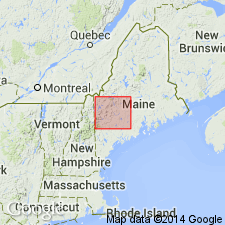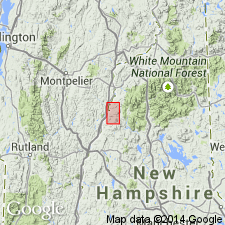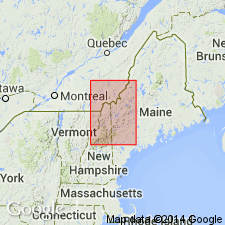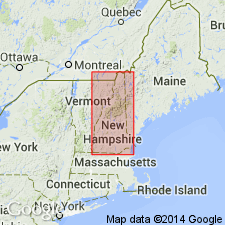- Usage in publication:
-
- Quimby Formation
- Modifications:
-
- Original reference
- Dominant lithology:
-
- Metashale
- Metagraywacke
- AAPG geologic province:
-
- New England province
Moench, R.H., 1969, The Quimby and Greenvale Cove Formations in western Maine: U.S. Geological Survey Bulletin, 1274-L, p. L1-L17.
Summary:
Pg. L4-L5 (fig. 2), L6-L12. Quimby Formation. Rocks previously included in "northern argillite" by E.S.C. Smith (Amer. Jour. Sci., 5th ser., v. 5, 1923). Divided into (descending): (1) shale member, rusty-weathering, cyclically interbedded medium-gray to black metashale and subordinate metagraywacke, thickness up to 2,000+/- feet; and (2) graywacke member, interbedded light- to light-brownish-gray metagraywacke, slate-chip metagraywacke, and polymictic conglomeratic metagraywacke, thickness up to 1,000+/- feet. Conformably underlies Greenvale Cove Formation (new). Overlies Dixville Formation with probable gradational and conformable contact; base poorly exposed, contact arbitrarily placed where alternating 1- to 3-inch beds of black sulfidic metashale of the Dixville give way to thicker sequence in which metagraywacke is predominant. Considered Upper Ordovician(?) based on stratigraphic relations.
Type area: lower part is between Quimby Pond and Hunter Cove; upper part is on shores of Rangeley Lake and core of Brimfield anticline, Rangeley 15-min quadrangle, central western ME.
Source: Publication; US geologic names lexicon (USGS Bull. 1520, p. 250).

- Usage in publication:
-
- Quimby Formation*
- Modifications:
-
- Revised
- AAPG geologic province:
-
- New England province
Summary:
Divided into lower graywacke member 300 m thick and upper shale member 600 m thick in type area. Overlies Middle Ordovician volcanic rocks; underlies Silurian Greenvale Cove Formation.
Source: GNU records (USGS DDS-6; Reston GNULEX).

- Usage in publication:
-
- Quimby Formation*
- Modifications:
-
- Revised
- Areal extent
- AAPG geologic province:
-
- New England province
Summary:
Stratigraphy differs radically from that of Hadley (1942, 1950), White and Billings (1952), in Mt. Cube and Woodsville 15-min quads, respectively, and revisions of Rumble (1942) east of Connecticut River. Fundamental difference is that Moench recognizes seven formations (plus members) that constitute Piermont allochthon. Hadley (1942) mapped all of these as Albee Formation, a name not used in this report. Rocks previously mapped as Albee are reassigned to stratigraphic equivalents of Quimby (Upper Ordovician?), Greenvale Cove (Lower Silurian), Rangeley (Lower Silurian), Perry Mountain (Silurian), Smalls Falls (Upper Silurian), Madrid (Upper Silurian?), and Littleton (Lower Devonian) Formations, whose type localities, except for Littleton, are near Rangeley, ME (Moench and Boudette, 1987). Within allochthon, only uppermost 100 m of Quimby is preserved. Consists of black sulfidic schist and metagraywacke. Report includes geologic map and correlation chart.
Source: GNU records (USGS DDS-6; Reston GNULEX).

- Usage in publication:
-
- Quimby Formation*
- Modifications:
-
- Areal extent
- Age modified
- Overview
- AAPG geologic province:
-
- New England province
Summary:
Geographically extended into NH from western ME. Mapped in various areas in Bronson Hill-Boundary Mountains anticlinorium. In area of Rangeley Lake, ME, divided into euxinic shale and graywacke member, an underlying graywacke member, and a felsic volcanic member that grades laterally with graywacke member; also includes garnet granofels unit at Loon Lake. In Old Speck Mountain, ME, and Milan, NH, 15-min quads, only euxinic shale and graywacke member is exposed. In Littleton and Moosilauke, NH, 15-min quads, divided into upper euxinic shale and graywacke member and a conformably underlying felsic volcanic member (which, north of Ammonoosuc fault, is divided into two layers separated by a sedimentary and mafic volcanic facies). Felsic volcanic member and sedimentary and mafic volcanic facies were previously mapped as upper member of Ammonoosuc Volcanics by Moench (1990, 1992). Quimby is here assigned Ordovician (Cincinnatian) age on basis of U-Pb zircon age of 444 +/-4 Ma obtained from basal felsic metatuff of felsic volcanic member (Aleinikoff and Moench, 1992); because age is within error margin of Ordovician-Silurian boundary of Tucker and others (1991; about 441 Ma) possibility exists that uppermost Quimby may be Silurian.
Source: GNU records (USGS DDS-6; Reston GNULEX).

- Usage in publication:
-
- Quimby Formation*
- Modifications:
-
- Overview
- AAPG geologic province:
-
- New England province
Summary:
Used as Late Ordovician(?) Quimby Formation. Consists of black, rusty-weathering, thickly bedded, graphitic-sulfidic metagraywacke. Report includes geologic map, cross sections, correlation chart, and four 1:500,000-scale derivative maps.
Source: GNU records (USGS DDS-6; Reston GNULEX).
For more information, please contact Nancy Stamm, Geologic Names Committee Secretary.
Asterisk (*) indicates published by U.S. Geological Survey authors.
"No current usage" (†) implies that a name has been abandoned or has fallen into disuse. Former usage and, if known, replacement name given in parentheses ( ).
Slash (/) indicates name conflicts with nomenclatural guidelines (CSN, 1933; ACSN, 1961, 1970; NACSN, 1983, 2005, 2021). May be explained within brackets ([ ]).

